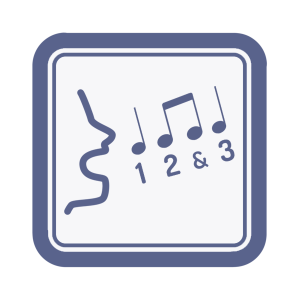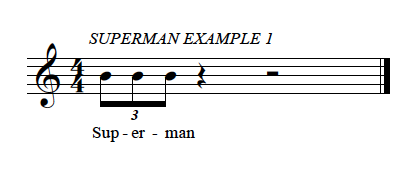
Speak Rhythms
Discover two methods you can use to speak out a rhythmic pattern from written notation or know how to write down a rhythm you’ve heard: the count chant method and the Kodály method.
After completing this module: you will understand two methods for speaking out rhythmic patterns.
Learn the count chant and Kodaly methods, how to count out complex syncopation and compound meters, and helpful training exercises to help you work on basic rhythm patterns using 16th notes and triplets. These lessons build on each other, giving you a solid foundation in rhythm.
Module Preview
Below is a sample introductory lesson for Speak Rhythms in which you can learn some easy tricks for counting triplets and simple rhythms.
Contents
- Introduction
- Count Chant: Basics
- Count Chant: Rests
- Count Chant: 16th Note Patterns
- Count Chant: Triplets
- Count Chant: Compound Meters
- Kodály: Basics
- Kodály: Syncopation
- Putting It All Together
- Try It: Rock
- Try It: Jazz
- Try It: Latin
- Jam Time
Introduction
Are you having difficulty understanding rhythm notation? Sometimes a complicated string of syncopated 16th notes and 8th notes may seem too difficult to comprehend – let alone transcribe them, or sight-read from notation.
Don’t worry! You are not alone if you have difficulty understanding rhythm notation.
Thankfully there are ways to “speak rhythm” that will help you understand rhythm like the best of the rhythm masters. In this module, you will learn two simple methods to let you better understand rhythm by ear.
Many musicians struggle with understanding rhythm, especially if their primary musical skills are melodic like singing or playing an instrument like the flute, or they play a low brass instrument or bass guitar that usually do not have complex rhythms. In fact, percussionists and pianists often seem to have the monopoly on great rhythm! Well, now you can learn their secrets.
How to Speak Rhythm
If you have ever watched two percussionists chat about rhythm, you might wonder if they are speaking an entirely different secret language as they start spouting out a string of nonsensical syllables like “three ee and ah” or “ta ti ti ta”. Believe it or not, you don’t need a translator, and all drummer jokes aside, these people are actually quite sober… What they are doing is using simple short words like “ta” or “e” or “tika” to represent rhythm notation.
Here’s a simple and useful example: you can use a word like “superman” to represent rhythms like triplets:

In this example, each syllable of the word “su-per-man” lines up with a triplet. So you can repeat saying “superman” over and over again to “speak” the triplet rhythm.

Why Speak Rhythms?
If you are like most musicians, rhythmic notation can be daunting, especially if more complicated syncopated rhythms are involved. Learning how to speak out rhythms helps you easily read and write rhythms in notation but (more importantly) it gives you the mental frameworks for really understanding how rhythms you hear or play are put together.
What You Will Learn
In this module you will learn how to count rhythms out loud using two methods: count chantand the Kodály approach. Both of these are easy ways to understand rhythmic notation using simple syllables. Easy exercises will present you with opportunities to practice and apply what you have learned
Let’s take a quick look at each of these two methods.
The Count Chant Method
The count chant method is a very common method using syllables like “and” or “ah” to stand in for more complicated rhythms.
Here is a really simple example:

In this example the downbeat is represented by a number and the offbeats are represented by“and”. When you say “1 and 2 and 3 and 4 and” you are counting the eighth note rhythm out loud and keeping time.
Here’s an exercise to practice counting with the audio example above.
- Set your metronome to a moderate tempo
- Start by tapping your foot on the downbeat
- As you tap count 8th notes using “1 and 2 and 3 and 4 and”
Practice staying in time and counting the simple rhythm out loud. It is helpful if you look at the notation as you count to help your mind associate the visual image with the syllables.
When you first try tapping your foot while speaking a rhythm it can be a challenge! Some musicians compare it to trying to pat your head while rubbing your tummy. It can confuse the brain! If you find this too difficult, just practice saying the words without tapping your foot. You’ll learn later in this module why the foot-tapping is important for the count chant method, so do try to keep practicing this.
You can now start to practice counting 8th notes whenever you are listening to music.
The Kodály Method
The Kodály Method was developed by Hungarian composer Zoltán Kodály, who believed that learning music should instil joy in the student.
“Teach music and singing at school in such a way that it is not torture but joy for the pupil…”
— Zoltan Kodály.
Kodály developed his method to help young musicians develop musical skills in a simple way that was both helpful and enjoyable. The full method covers many aspects of musicianship, including solfa for relative pitch, and the rhythm-speaking method you’ll be learning about in this module.
The Kodály Method uses specific syllables for rhythm notation like the “ti” and “ta” mentioned earlier. In this module you will learn exercises that will help you develop your rhythmic skills using simple syllables.
So, are you ready to learn to speak rhythms? Let’s get started!

